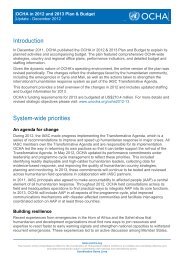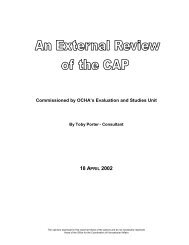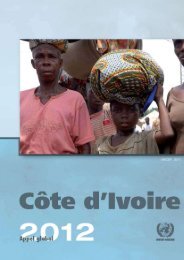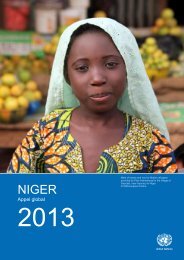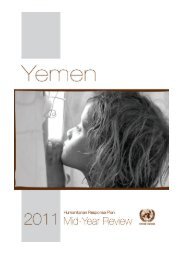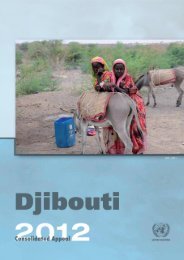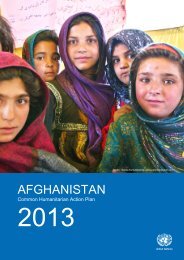Table of contents
Untitled
Untitled
Create successful ePaper yourself
Turn your PDF publications into a flip-book with our unique Google optimized e-Paper software.
United Nations and Partners[1] 2011 in review | updated needs analysisSudan work plan 201219Updated NEEDS ANALYSISThe 2012 Humanitarian Work Plan (HWP) contained a detailedneeds analysis that underpinned humanitarian action in 2012.This updated needs analysis focuses on the major changes inneeds during the first half <strong>of</strong> the year. Please refer to the 2012HWP for the comprehensive needs analysis, available at http://unocha.org/sudan/humanitarian-workplan.An estimated four million are in need <strong>of</strong> humanitarian assistancein Sudan. While the overall level <strong>of</strong> humanitarian needsis in line with the 2012 HWP projection, increased vulnerabilitybeyond current levels is a distinct possibility during the secondhalf <strong>of</strong> the year and humanitarian partners will continue tomonitor the situation closely to identify new needs as theyemerge. Contingency plans have been updated and can beactivated in the event <strong>of</strong> a worst-case scenario unfoldingFood Security and LivelihoodsFood security continues to be a key humanitarian concernin Sudan. The food security situation varies throughout thecountry, but, as the Famine Early Warning Systems Network(FEWSNET) indicates, up to 4.7 million people may be foodinsecureduring the second half <strong>of</strong> the year, particularly as therainy season is approaching which typically coincides with the‘hunger gap’ or lean season period when people’s food stocksare at their lowest. The most affected areas continue to be theDarfur states, South Kord<strong>of</strong>an, Blue Nile and eastern Sudan.Several recurring factors have combined to make food insecuritya persistent problem in 2012. Most acutely, low rainfallshave led to generally poor harvests in Sudan, especiallyin eastern Sudan, North Kord<strong>of</strong>an and Darfur in 2011. This,combined with a reliance on importing key food items thatare subject to fluctuating world prices. Increases in food pricesdisproportionately affects the poor the most, as the poorest20% <strong>of</strong> Sudanese spend up to three quarters <strong>of</strong> their incomeon food. For example, in North Darfur, the price <strong>of</strong> a minimumhealthy food basket has increased by approximately 30% sincethe beginning <strong>of</strong> 2012, and in South Darfur and West Darfur;the price <strong>of</strong> the minimum healthy food basket has increased by27% and 22% respectively. In South Kord<strong>of</strong>an and Blue Nile, acombination <strong>of</strong> poor rains and insecurity has reduced the 2012harvest to around a quarter <strong>of</strong> normal levels and the upcomingplanting season has been affected as some people do nothave access to agricultural inputs, land or commercial markets.Meanwhile, insecurity and displacement continues to affectaccess to livelihoods opportunities and access to commercialmarkets, which contributes to increased vulnerabilityand reduced resilience among populations in affected areas.Limited livelihoods opportunities, in IDP camps and in localcommunities continue to erode self-sufficiency and copingmechanisms and causes aid dependence. There is thereforean increasing need to provide livelihoods assistance thatpromotes resilience, improves their welfare and avoids longtermaid dependence. This needs to be done in conjunctionwith recovery and development partners who are also focusedon building livelihoods.NutritionGiven the ongoing conflict in several parts <strong>of</strong> Sudan whichprevents many vulnerable people from receiving the necessaryassistance, as well as the anticipated upcoming ‘hungergap’, it is clear that nutritional needs have not diminished overthe first half <strong>of</strong> 2012. The new displacements in Darfur, SouthKord<strong>of</strong>an and Blue Nile may result in increased malnutritiondue to food insecurity and fewer livelihoods opportunities.The nutritional situation therefore needs to be closely monitoredand interventions may need to be intensified.While nutrition surveys for the 2012 mid-year update haveyet to be released, the latest available data indicates thatglobal acute malnutrition (GAM) levels for children underfivein Sudan are at 16.4%, which is above the internationallyaccepted emergency "criticial" threshold <strong>of</strong> 15%. Of these,5.3% <strong>of</strong> the children are suffering from severe acute malnutrition(SAM). This means that, during 2012, more than half amillion children are likely to be suffering from SAM in Sudan atany time and up to 1.5 million children will suffer from moderateacute malnutrition (MAM) during the year.HealthThere are no significant new needs in the health sector at themid-year point but the health situation in Sudan remains anongoing concern. The public health system is fragmented,FOOD Aid SUDANFood aid flows to SudanWFP food aid distributions (in ‘000 metric tons)1990199219941996199820002002200420062008201020111,000800600400200Source: WFP Food Security Monitoring System Reports (2012)0FOOD Aid DARFURFood aid flows to Darfur● Planned ● Actual beneficiaries, in millionSep-09Dec-09Mar-10Jun-10Sep-10Dec-10Mar-11Jun-11Sep-11Dec-11Mar-124.03.53.02.52.01.51.0Food aid beneficiaries in Darfur (May '12)● Residents ● IDPs ● Refugees and returneesCategory # <strong>of</strong> benef.IDPs [1] 1,431,606Residents [2] 230,548Refugees andreturnees [3]8,047Total 1,670,2011,670,201beneficiaries0% [3]14% [2]86% [1]




